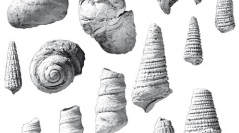

 Geodiversitas
30 (2) - Pages 261-285
Geodiversitas
30 (2) - Pages 261-285This paper deals with Oligocene molluscan biostratigraphy of the Denizli and Kale-Tavas subbasins. A total of seven stratigraphic sections have been logged and lagoonal and brackish-shallow marine molluscs (11 gastropod and seven bivalve species) have been sampled. The molluscan fauna indicates the Rupelian age by the presence of characteristic species: for gastropods Haustator conofasciata (Sacco, 1895), Ampullinopsis crassatina (Lamarck, 1804), Tympanotonos trochlearispina (Sacco, 1895) and Tympanotonos conjunctoturris (Sacco, 1895) and for bivalves Pycnodonte gigantica callifera (Lamarck, 1819) and Gari cf. protracta (Mayer-Eymar, 1893). These sections also contain typical Oligocene benthic foraminifer and coral fossils which are characteristic for the whole Tethys Province. The corals (Glyphastraea laxelamellata (Michelotti, 1838), Siderastrea (Siderofungia) morloti (Reuss, 1868), Antiguastraea alveolaris (Catullo, 1856), Astrocoenia bodellei (Calmus, 1973)) represent the Rupelian-Chattian age and the occurrence of the benthic foraminifer Nephrolepidina partita Douvillé, 1911, indicates SB22 biozone (late Rupelian-early Chattian). Therefore, both two groups support our age attribution. Litho- and biostratigraphic correlation of the sections points out that Oligocene lagoonal-marine deposits of the Denizli and Kale-Tavas subbasins (Sağdere and Mortuma Formations respectively) are assigned to late Rupelian-early Chattian. Paleobiogeographically, the distribution of the molluscan species suggests that the studied region belongs to the Mediterranean-Iranian Province.
Oligocene, Mollusca, biostratigraphy, paleoecology, paleoenvironments, paleobiogeography, SW Turkey, Mediterranean-Iranian Province